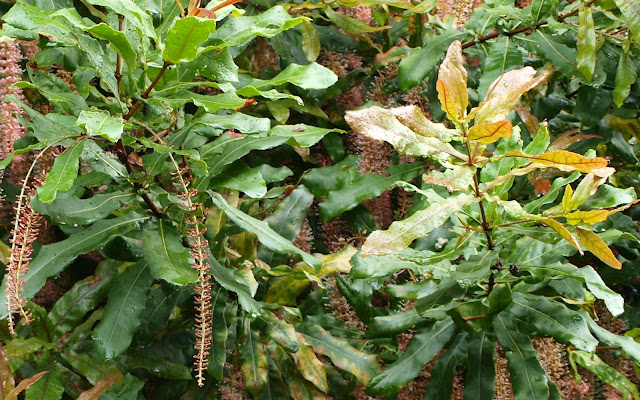South African border wall of Wild Almond
Before the walls in Berlin, Gaza and Mexico, there was Van Riebeeck's Hedge around Cape Town. This hedge did what those others do, or are planned to do: keep others out or in. In this case the wall was constructed out of plants, a hedge of Wild Almond.
Before I was interrupted by a few weeks of archival posts (which I hope you enjoyed, or at least tolerated patiently), I was singing the praises of the plant family Proteaceae. As a contrast to the Saw Banksia (Banksia serrata) from Wilsons Promontory, I followed up with the unhelpfully named Blueboy (Stirlingia latifolia) from Western Australia.
This post continues that theme. Wild Almond is the only South African member of a plant subfamily (the Grevilleoideae) including banksias, grevilleas, hakeas, and many other familiar Australian plants from the protea family (Proteaceae). It's closest relative is the Australian and New Caledonian Macadamia.
It's not a beautiful tree and it is most famous for its ability to form a hedge, in particular one dividing the Dutch settlers in Cape Town from those living in South Africa prior to their arrival.
Ghoe - the almond shaped fruits covered in brown velvety hairs - are collected and eaten by the local people of the Cape Town region, the Khoikhoi. Despite the English name of Wild Almond the fruits are poisonous. Yet, as with other poisonous plants (e.g. cycads, nardoo in Australia), if prepared correctly they can be eaten. The Khoikhoi soaked the fruit in water for several days, then boiled and roasted them. Some early explorers didn't, and died.
When the Dutch East India Company arrived in Cape Town in 1652, they quickly established gardens and orchards, excluding the Khoikhoi from the settlement and a food source. In 1660 the Khoikhoi sought access to trees within the settlement area. In response, the Company planted a hedge from the fruits to keep out the Kohikhoi and to contain stock (as was done in Holland). That became the infamous Van Riebeeck's Hedge.
Outside Cape Town, the fruits float and are mostly dispersed by water. The seeds are short-lived and germinate quickly. This allows them to get purchase on the river bank rather than lie around until winter rains wash them out to sea.
So for the new settlers, the hedge was easy to establish from freshly fallen fruit. Fittingly, perhaps, I have no pictures of the fruit, only the tangled thicket of branches and occasional trunk. This close up of some leaves reveals the lack of resolution in my pictures but it does show they are not unlike the Macadamia (in the picture following, taken in Royal Botanic Gardens Sydney a few years ago).
The timber, as you can see here in the last picture, is red. It's a tough wood, and difficult to saw, but used to make bowls, wagon rims, brake blocks and... the heels of Dutch shoes.
Images: Kirstenbosch National Botanical Garden, taken in August 2018 and with local fynbos botanist, Rupert Koopman, featuring in the top couple.





Comments